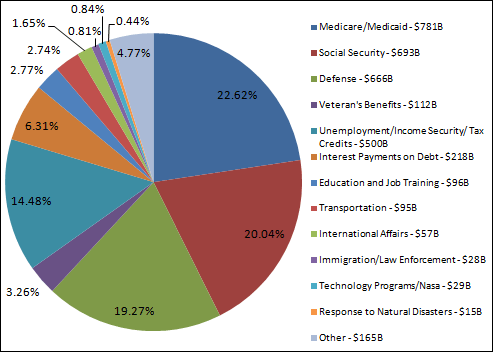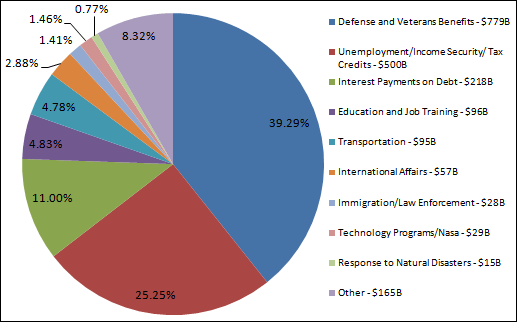Pop quiz: What percent of our federal budget goes to the military?
If you look at the “official” budget numbers, the White House reports that Defense spending takes up just over 19% of our budget.
Here is what our government spent in 2010, as reported by the Office of Management and Budget and the Department of the Treasury:

At first glance, this looks like a reasonably balanced chart, without any single slice of the pie taking up too much of the available dough (the pun was intended, although the joke was – admittedly – kind of crusty).
However, there’s been an unfortunate trend which started sometime around the Reagan era, where they try to “de-emphasize” the amount we spend on Defense by including Medicare/Medicaid and Social Security in the budget numbers. They also play other games, like breaking “Veteran’s Benefits” out of the “Defense” category.
So what’s wrong with including Medicare/Medicaid and Social Security in the Federal budget numbers?
Social Security and Medicare are insurance policies. The policy premiums are automatically deducted from your paycheck, completely separate from income tax, and the money is paid into separate trust funds which are (theoretically) managed independently from all government operations.
From a legal standpoint, the money is formally entrusted to the “Federal Old-Age and Survivors Insurance Trust Fund” for Social Security, the “Federal Disability Insurance Trust Fund” for disability, and the “Federal Medical Insurance Trust Fund” for Medicare. These “Trust Funds” are separate legal entities, with financial accounts independent from the U.S. Treasury.
But the way it’s currently reported is like allowing a company to include employee’s pension contributions as income, and claiming retirement benefits paid out of the pension fund as expenses, on its corporate income statement! Ridiculous, right? A company’s pension plan and it’s operating accounts should be completely separate, with separate reporting. And absolutely no co-mingling of funds – that would be considered fraud.
Medicaid is administered under federal guidelines, but it’s actually a state-run program. If each individual state is responsible for collecting/managing/disbursing this money, why does it show up as an expense under the federal budget? (and yes, there is some federal contribution, but the numbers that get reported include the total collected by all 50 states, not just the federal amount.)
If we use all the exact same numbers from the chart above, but remove the Medicare/Medicaid and Social Security expenses, and merge Veteran’s Benefits into the Defense category, then the federal spending pie chart looks like this:

Now you get a more realistic picture of our spending – with almost 40% of our tax dollars going to the military. This is much more reminiscent of what the “official” reports used to look like, back before they started playing these games with the numbers (ok, we didn’t have the high percentage on Unemployment/Income Security back then – hopefully this will go back down).
And of course, I haven’t touched on the fact that our tax revenue doesn’t come anywhere near enough to pay for all this – so just like a company which “borrows” from its pension plan, the government has been raiding the Social Security fund for many years *. This is money that should be accounted for as debt, not as income. Likewise, any money the government puts back INTO social security should show up as debt re-payments, not as an operating expense. Unfortunately, that’s not how they’re doing it, and everyone suspects that there IS a co-mingling of cash between the federal coffers and the Social Security trust fund. It’s one thing if the Social Security Fund invests in treasury bonds, it’s an entirely different thing if they just mix it all together.
Does anyone really know how much the Federal Government owes to Social Security? I sure don’t. That’s another number they manage to hide ... and it’s a big number.
I just wish our Federal Government was held to the same accounting and reporting standards that we expect of public companies on wall street.
-----------------------------------
* Despite all the news about Social Security going broke, they are STILL collecting far more in premiums than what is paid out in benefits – for now.